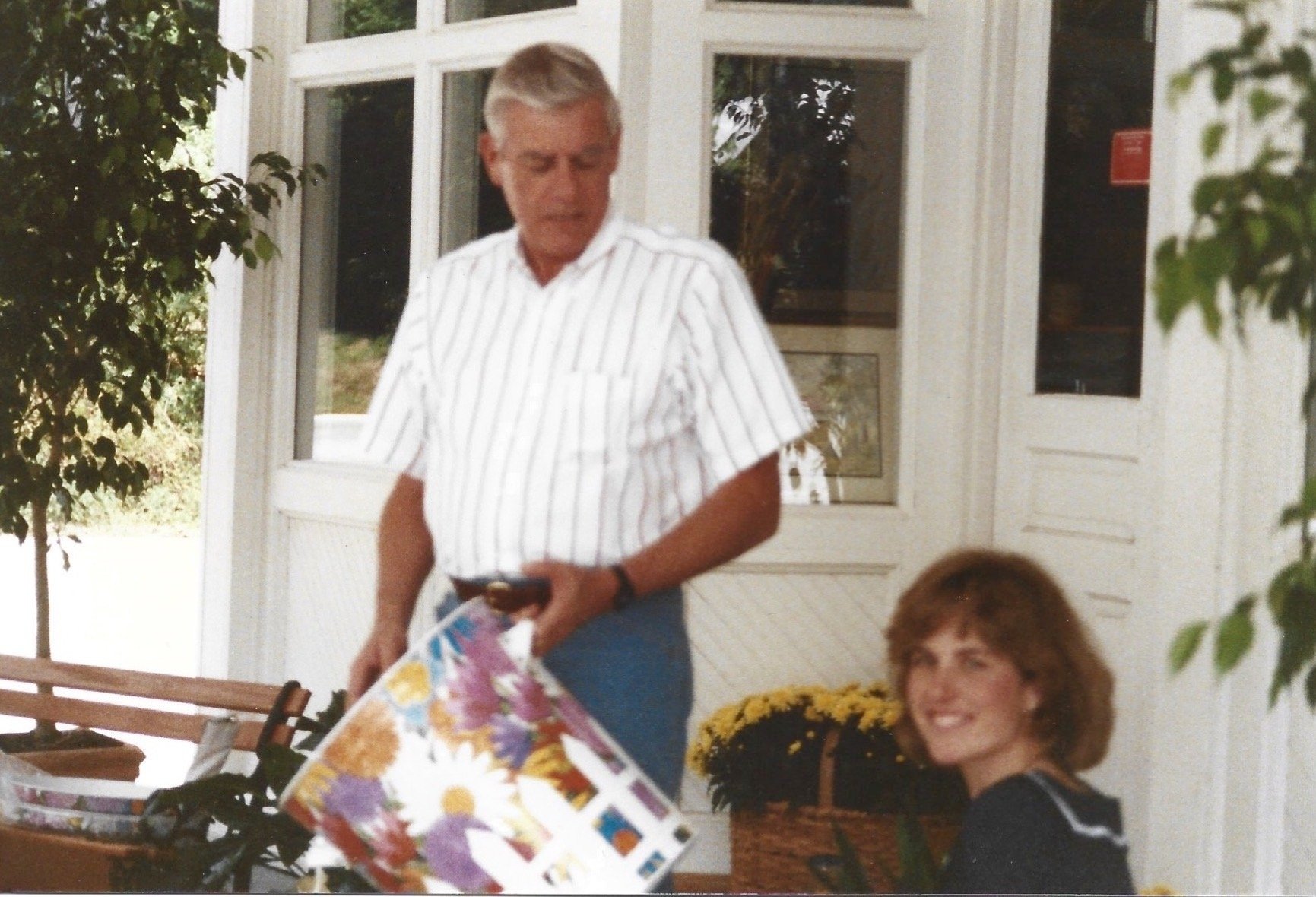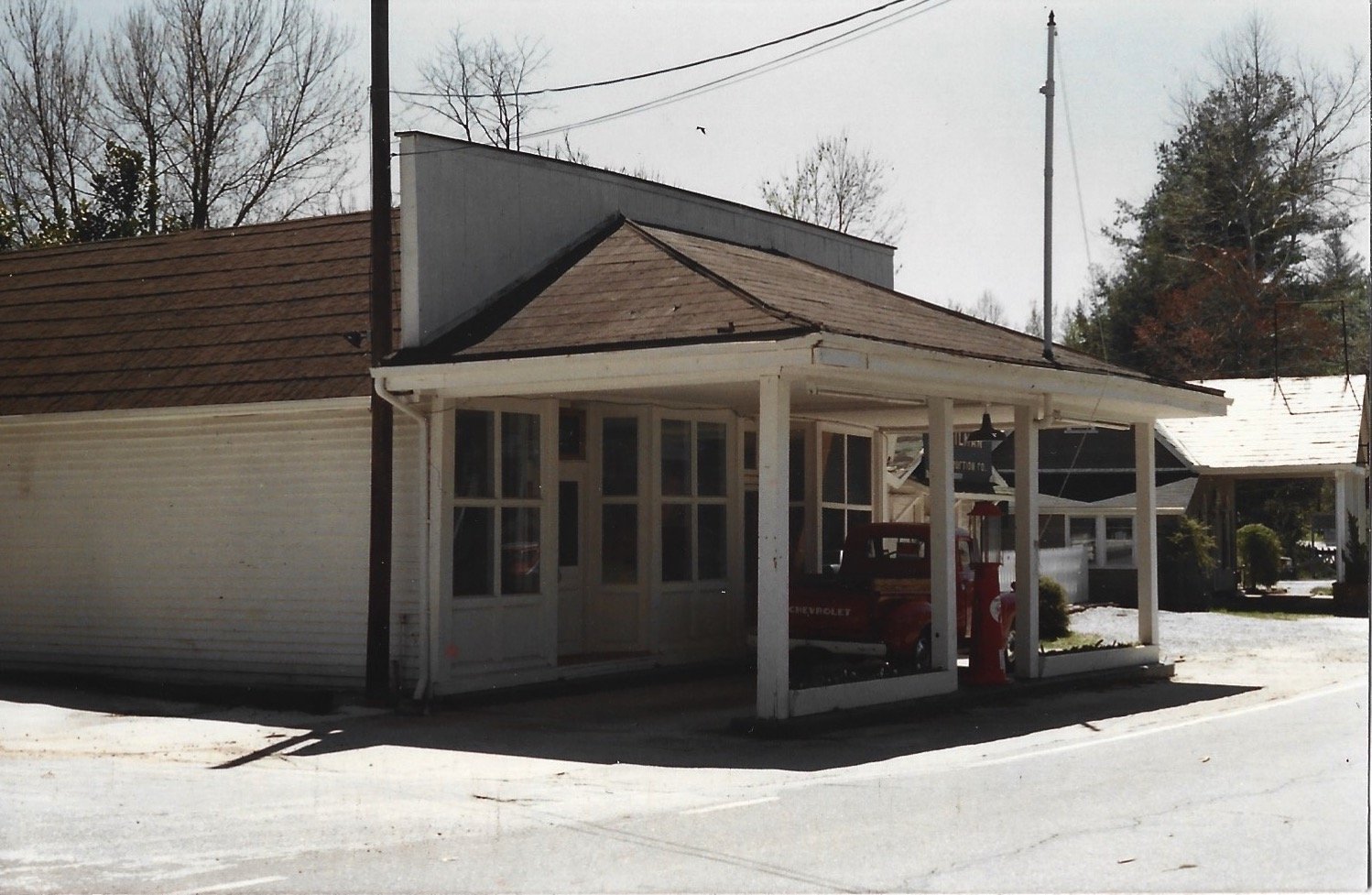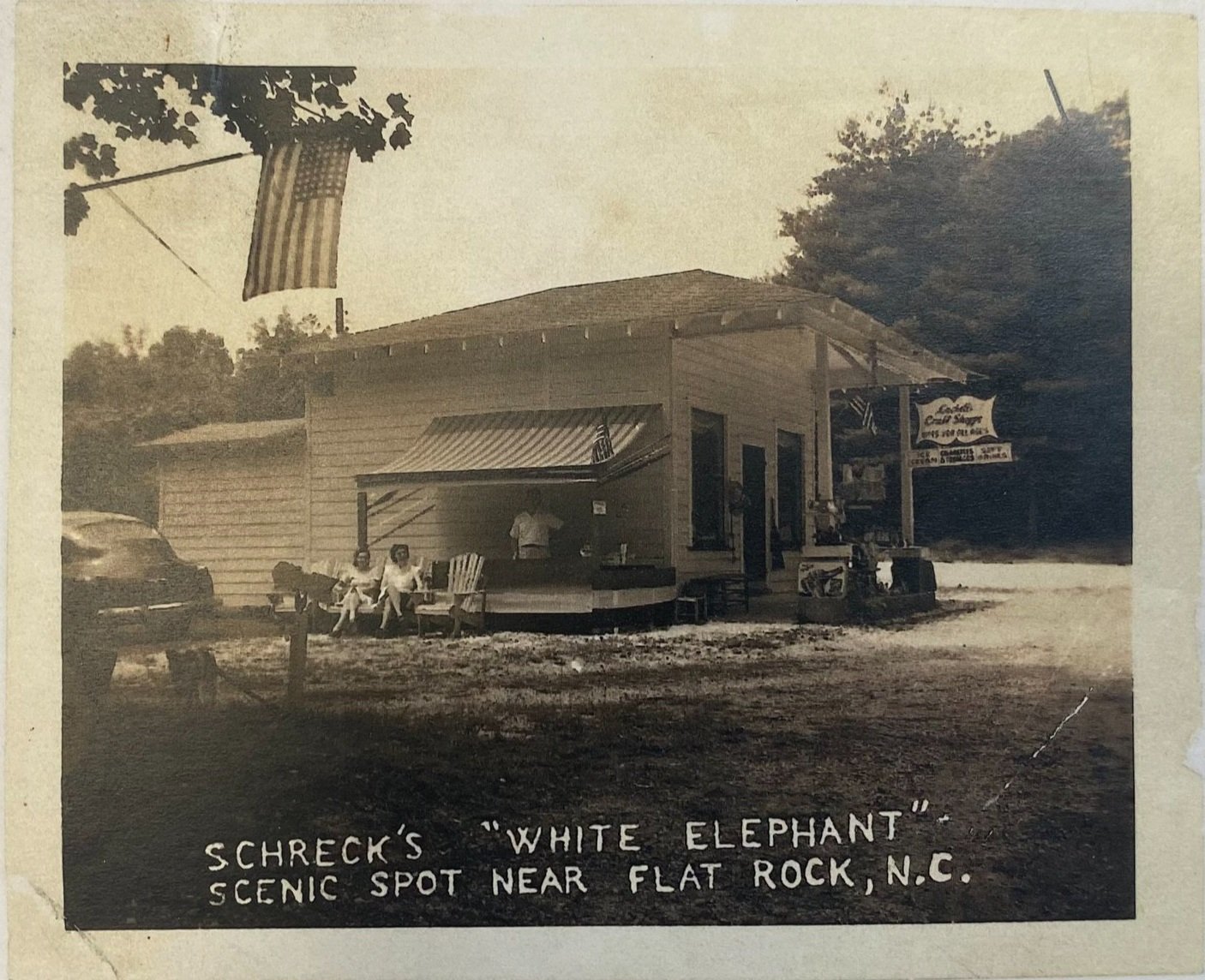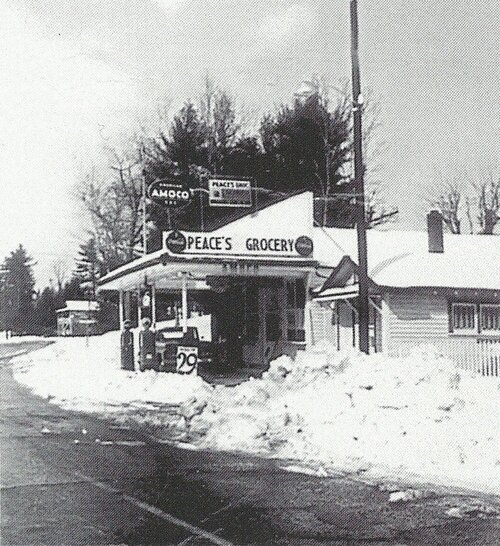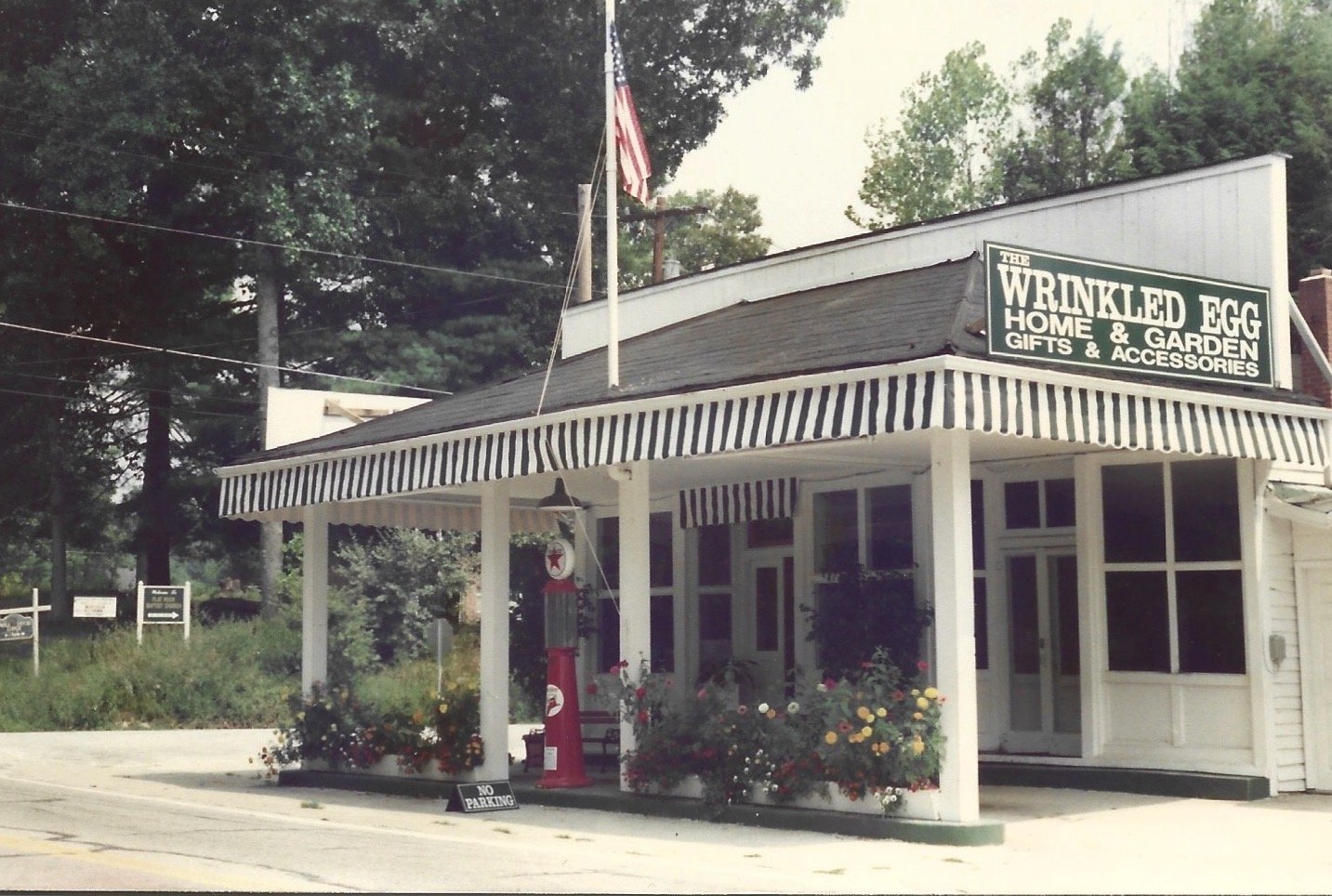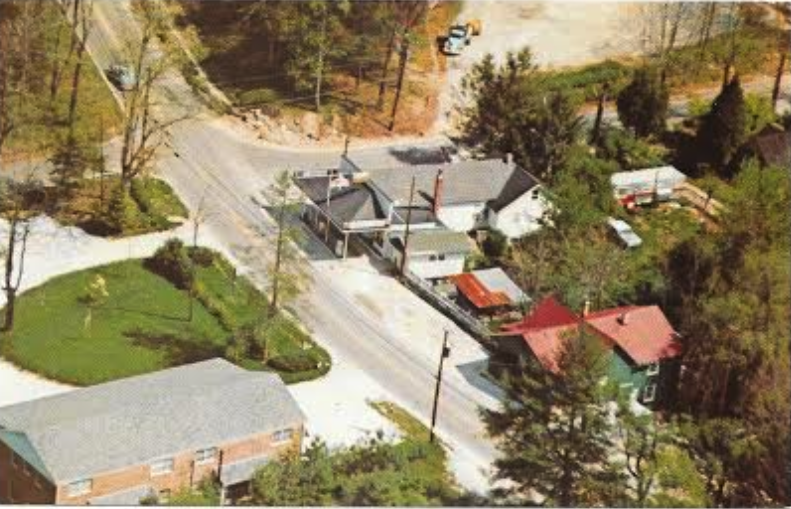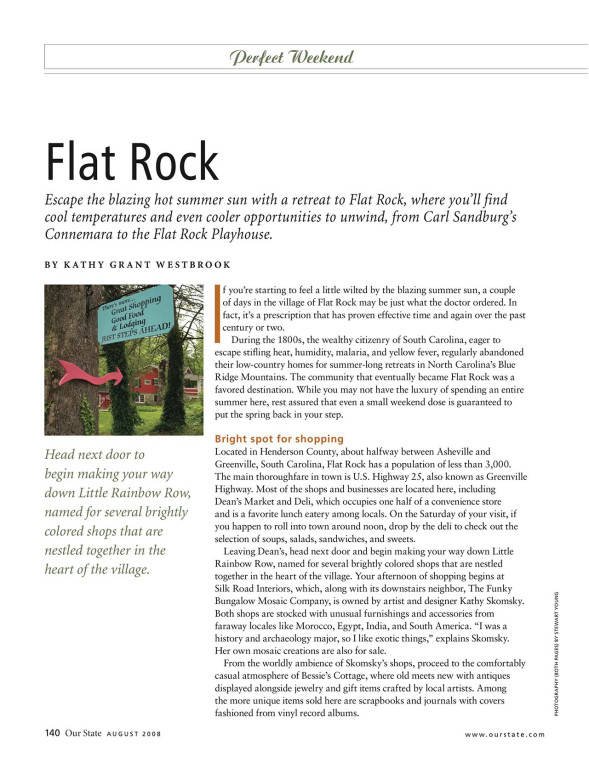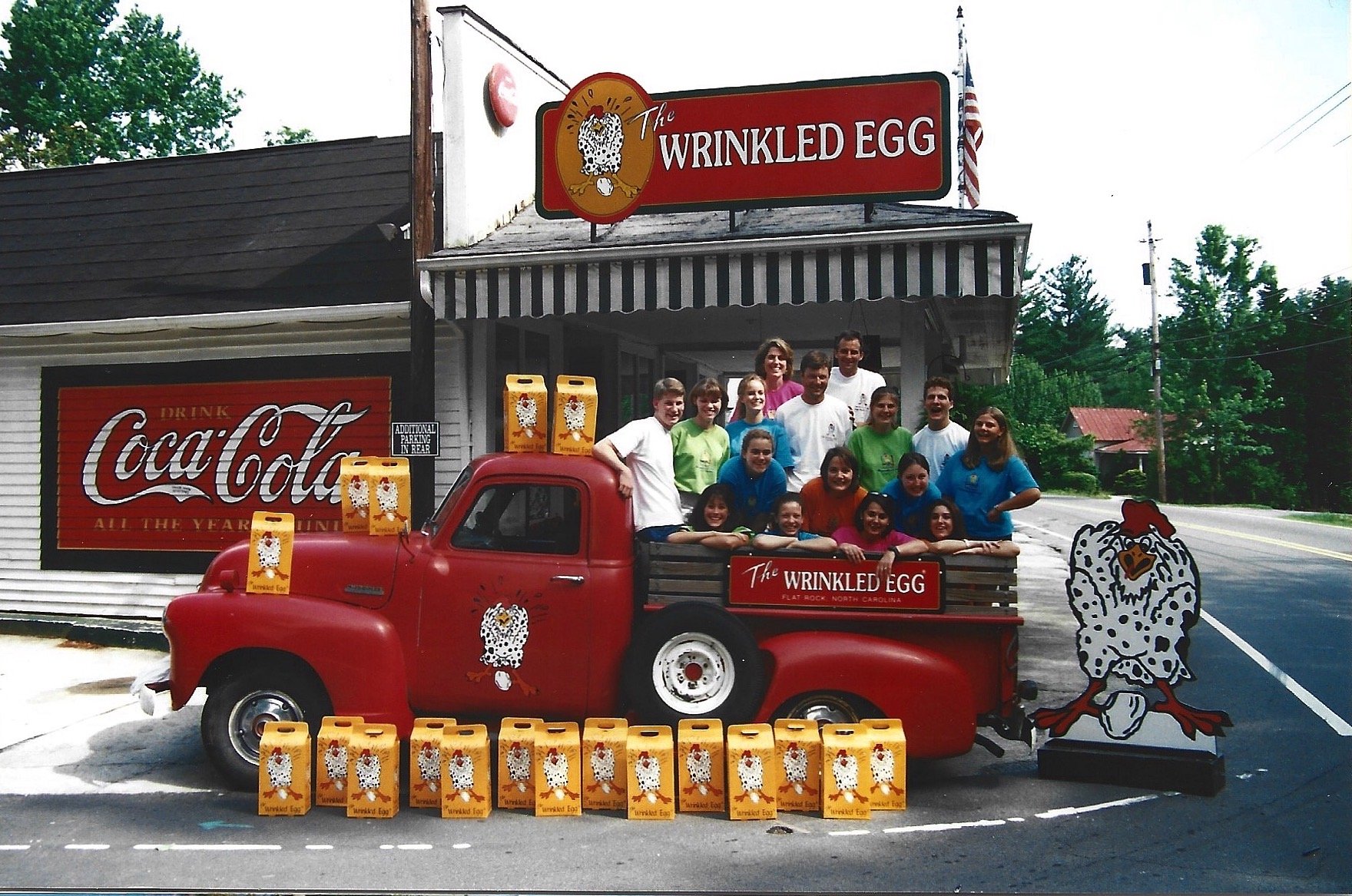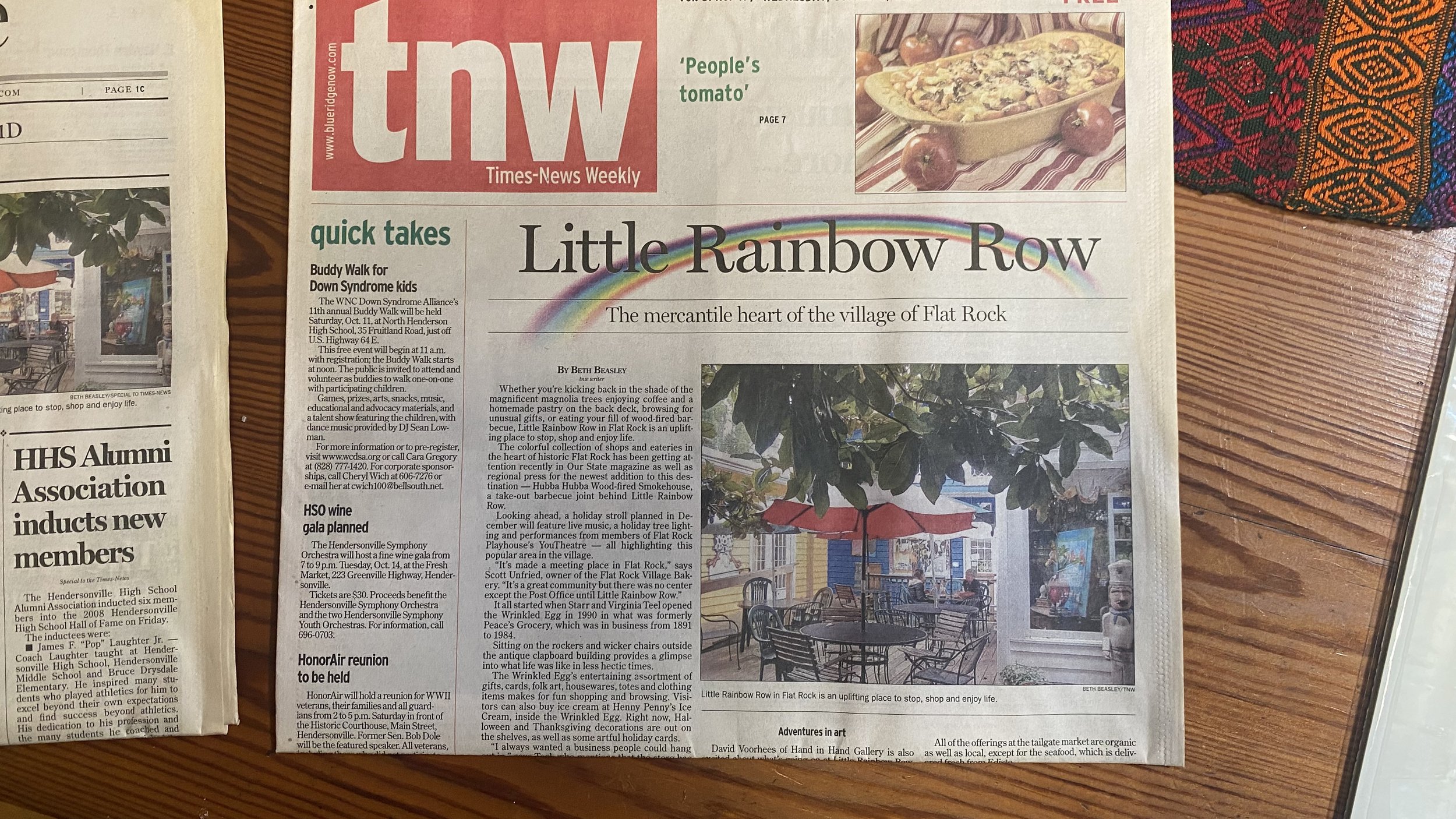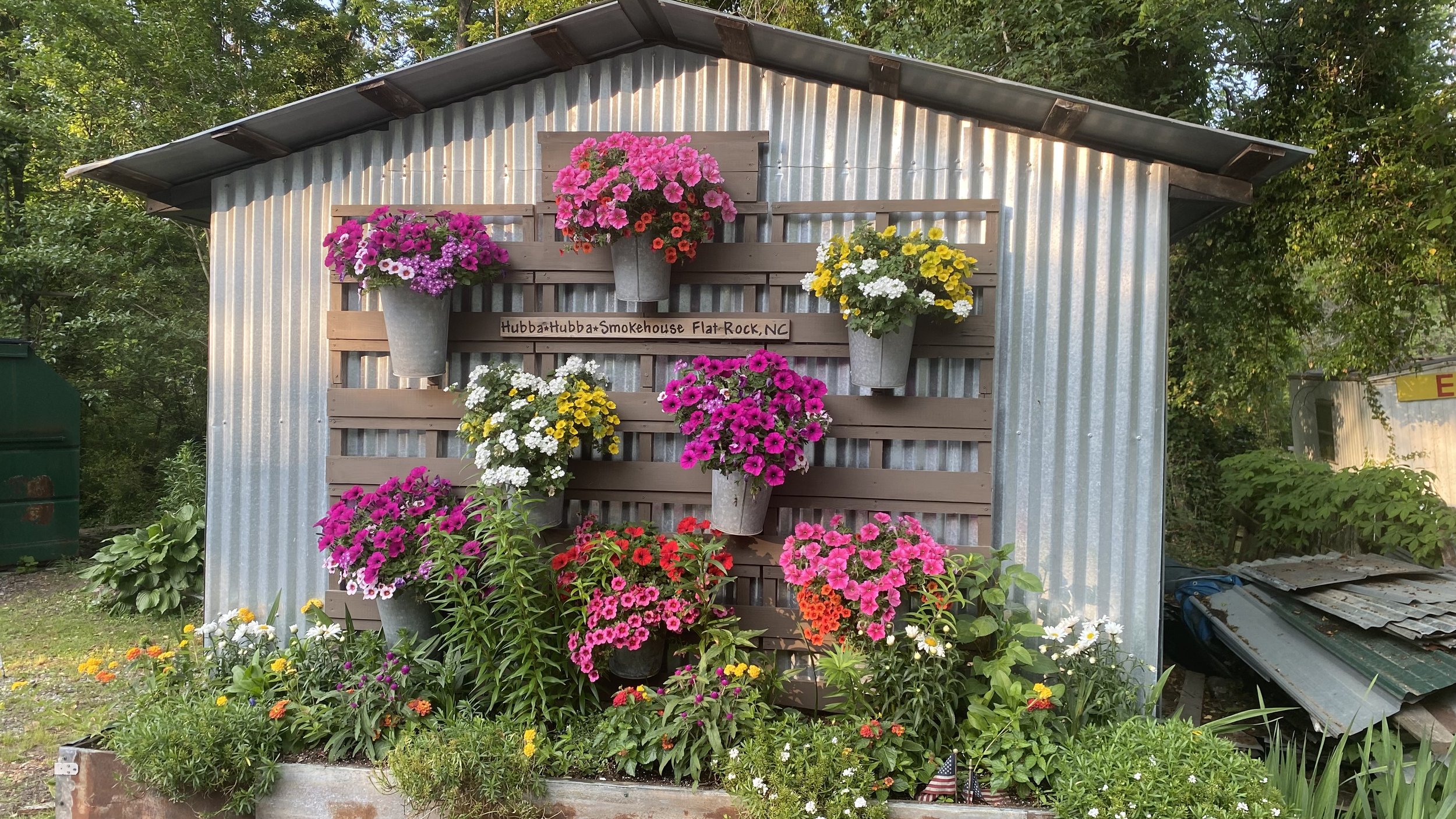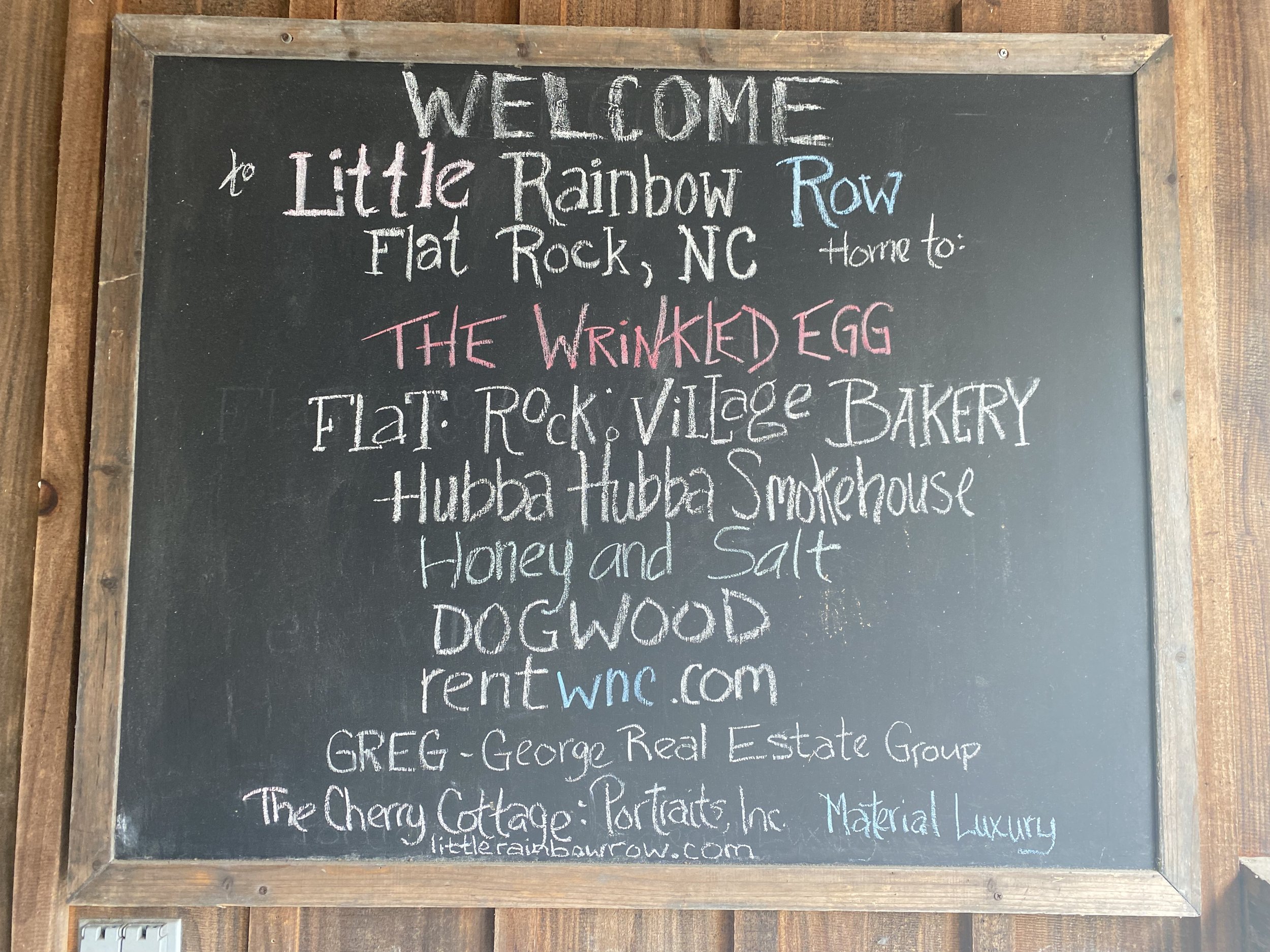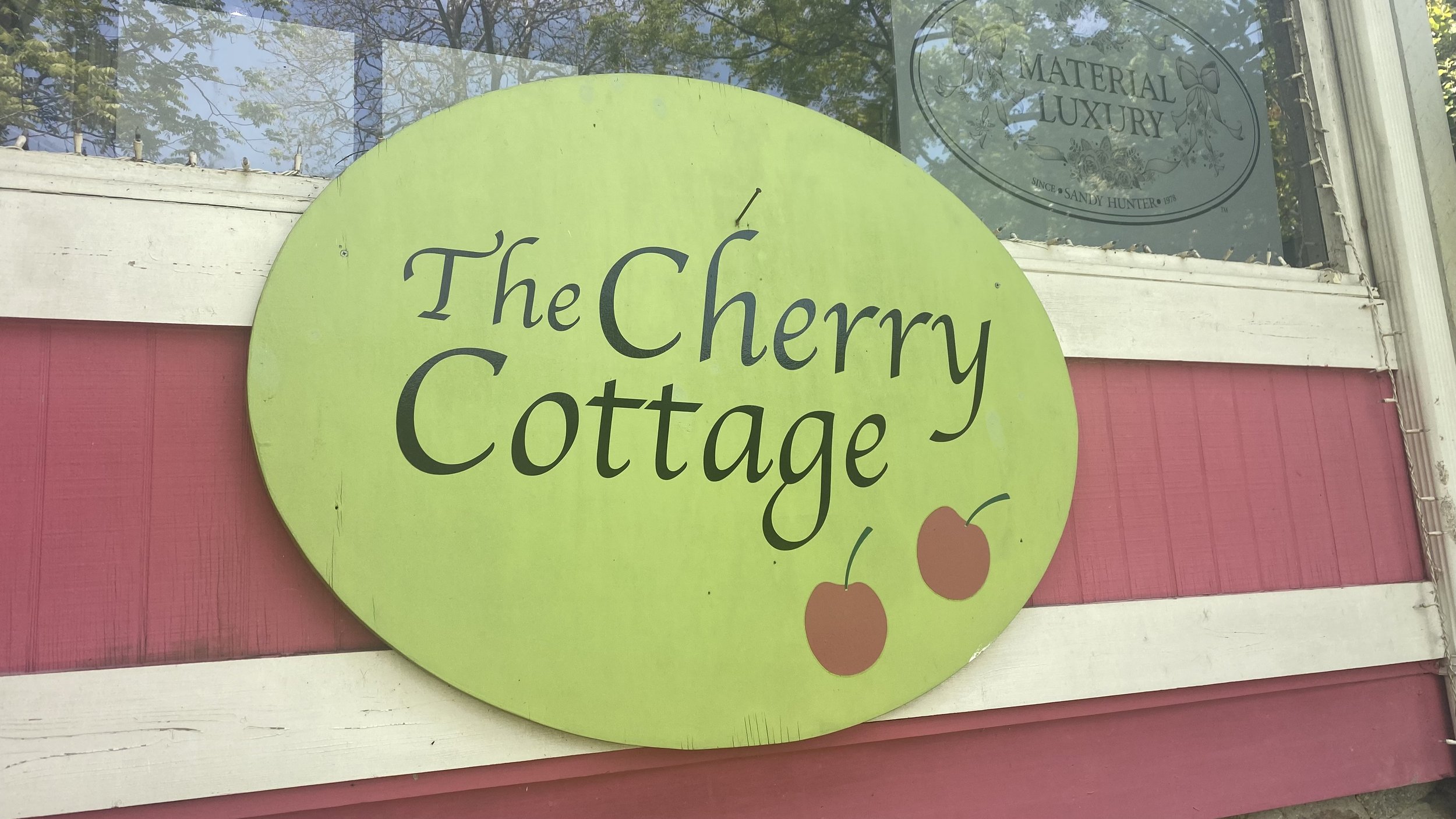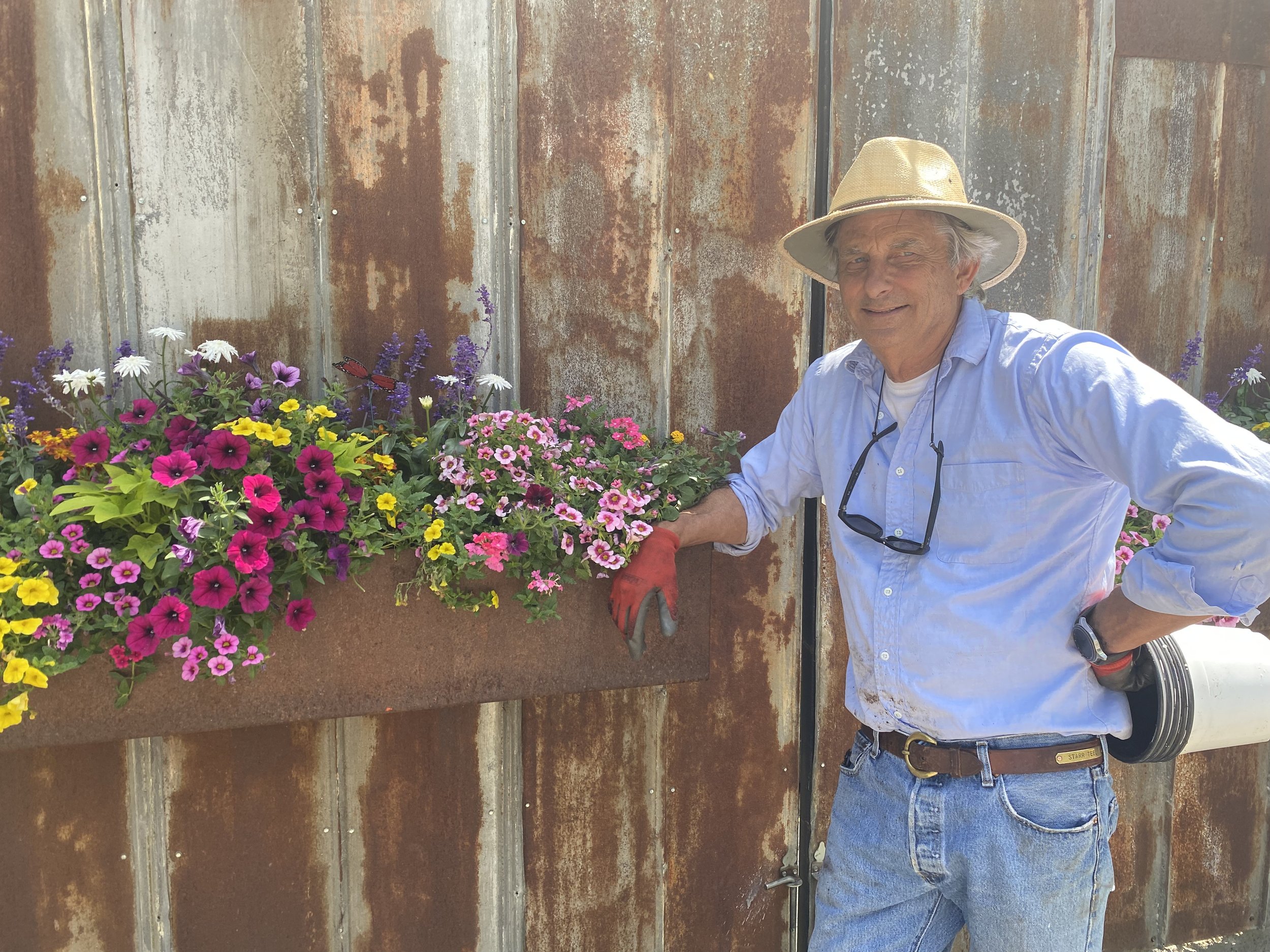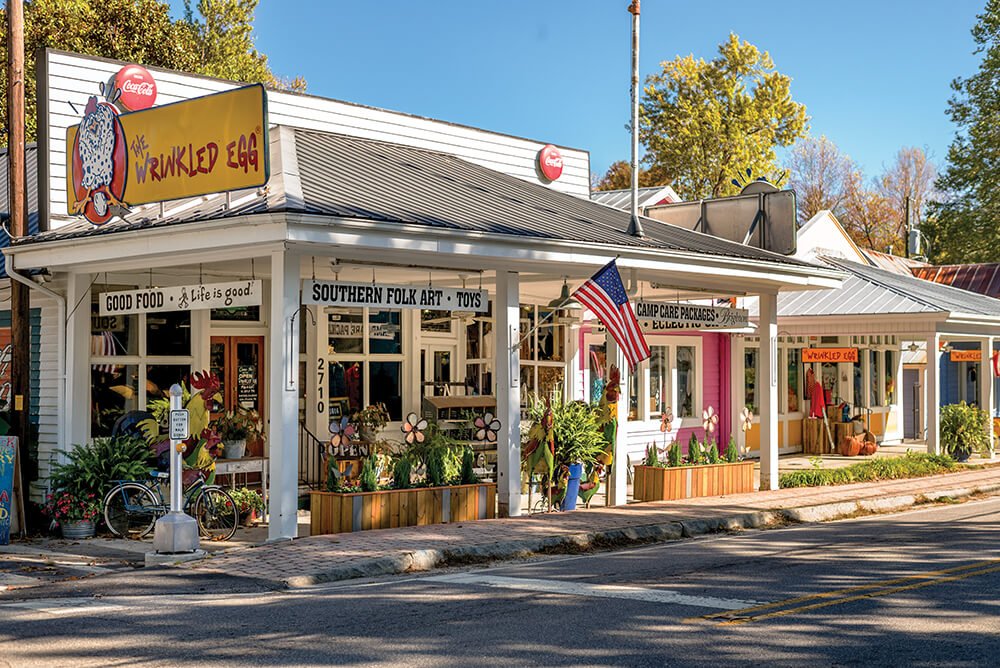Building a Rainbow
/Little Rainbow Row 2004; Painting by James Morrison
Little Rainbow Row is now such a common phrase in the local lexicon, it is easy to assume that the colorful moniker applied to the village business district has always been a part of the historic tapestry of Flat Rock. In reality, however, the brightly painted buildings that define Little Rainbow Row are a relatively new addition to the Village’s already colorful 216-year history.
--
Depending on how you prefer to mark the seminal moments of Flat Rock history, one could make the case that Little Rainbow Row can trace its origins to the construction of a simple storefront building (ca 1900) at the corner of Greenville Highway and West Blue Ridge Road that would become Peace’s Grocery and serve as a shopping beacon for Flat Rock residents for nearly eight decades. Perhaps more accurately, however, the genesis of Little Rainbow Row should be attributed to a young couple, Starr Teel and Virginia Spigener, who in 1987 saw exciting new possibilities in a very old and dilapidated building. Ironically, the first building block of the future Rainbow Row was Peace’s very plain white building.
Peaces Store CA 1924. Photo provided by Barbara Peace Lohman
The early history of Peace’s Grocery is documented in the Flat Rock Historic District renomination document compiled in 2015. That document relates the following about the building:
Peace’s General Store, ca. 1900
Standing at the intersection of Greenville Highway and Blue Ridge Road, this local landmark occupies land once known as "Mr. Farmer's Machine Shop" and "Mr. Farmer's Brick Yard." In 1900, E. J. Francis bought seventeen acres, built a store, and sold the two-acre store lot to the Peace family. Brothers Luther (1877-1943) and Melton Peace (1876-1959) operated the store in the first half of the twentieth century, and it was run by their nephew Clarence (1921-1984) until it closed in the 1980s.
Peace's General Store was known throughout the community not only for gas and groceries, but also as a meeting place, a landmark for directions, and a destination for sugar-hungry children.
After the death of Clarence Peace, the building was purchased by Historic Flat Rock, Inc. which in turn sold the building - with protective covenants - in 1987 to a young and very eager entrepreneur named Starr Teel. “They put it on the market on a Saturday and I had a contract on Monday,” Starr explains. Then he adds with a wry grin, “$73,000.”
Virginia in the Early Years of The WRinkled Egg
Working together with his future wife, Virginia Spigener, the couple spent their evenings after work cleaning up the old store and up fitting the space for a new business venture. In July of 1990, Virginia opened The Wrinkled Egg. Today, 33 years later, that same – albeit much larger - business is perhaps Flat Rock’s most iconic storefront and stands as the anchor for Little Rainbow Row. For Virginia, the store was both a business opportunity and a way to preserve a spot that held a special place in her heart from her days working at Camp Green Cove. “On my days off I’d gather my friends and we’d go to Peace’s to buy a Coke. Clarence was such a character from the past and I knew that one day it would go away.”
After 80 years as Peace’s Grocery, the name “The Wrinkled Egg” was a dramatic change for the plain white building. Initially, the new name created some confusion and consternation with the more traditional residents of Flat Rock who had only ever known the building as Peace’s. Virginia also recalls at least one resident who drove up to her front door and honked for service – as had been Clarence Peace’s custom.
Ultimately, it was the grand dame of Flat Rock history, Louise Howe Bailey who deflated the controversy surrounding the new name. “Louise said, ‘Of course, everybody knows what a wrinkled egg is. It’s something special,’” Starr recalls. “Louise was the one who put that to rest.”
Getting Started
Aerial View of Peace’s Grocery before renovations along Rainbow Row and the construction of the Singleton Center (now Flat Rock Square)
In 1990, there was no rainbow-colored business district in Flat Rock. In fact, it was a rather uninspiring stretch of Greenville Highway. In addition to The Wrinkled Egg, looking south there were three older residences and a recently closed mom-and-pop restaurant at the site of the present-day Campfire Grill. The buildings were drab, run-down, and by all appearances well past their prime. There was little indication of the vibrant business district to come.
There were also no stoplights in Flat Rock in 1990 and the sparse traffic through the village had few if any reasons to stop along that particular stretch of Greenville Highway. “I could sit outside and read a book sometimes for a couple of hours before somebody would ever stop”, Virginia recalls with a laugh. “I did that a lot.” Starr chimes in, “People don't realize how far out in the country we were at the time.”
The original Wrinkled Egg operation was just a fraction of its current size. Virginia estimates she had 600-700 square feet at the front of the building and shared it with a surveyor, David Huntley, as well as a small apartment in the back of the building (formerly Clarence Peace’s living quarters) where Starr lived early on. During the 1990s, Virginia’s business grew, and she very gradually expanded into more of the available space.
The early 90s also saw the arrival of two new businesses on the stretch of Greenville Highway. What we now know as the “Blue Building” (currently occupied by Dogwood, Rent WNC, and GREG) was purchased and the Secret Garden opened for business. In 1992, Dean’s Deli also arrived on the scene in the location of the current Campfire Grill. The Wrinkled Egg had company, but the rainbow effect was still a few years away.
In 1993, Starr purchased the building which was most recently the home to Honey & Salt Restaurant. David Huntley moved out of his space shared with Virginia and would spend the next 14 years in that building. His departure allowed Virginia to further expand The Wrinkled Egg.
Hand in Hand Gallery in the Blue Building 2002 -2012
Flat Rock’s blossoming rainbow got its real start when the Secret Garden closed down and Starr and Virginia – now married – purchased the building. The couple decided to paint the building a vibrant blue color to catch the attention of passersby. Molly Sharp, who along with her husband David Vorhees, would eventually move their own business into that building recalls, “It was the color of Virginia’s daughter’s dress.”
Starr also added a façade modeled after the Wrinkled Egg to make the area look less residential and more “townish.” Initially, the blue building was used as office space for Starr. It also provided Virginia a place to store and assemble materials used to build her very successful Summer Camp Care Packages which catered to the parents of the thousands of campers arriving in and around Henderson County each summer.
Although a far cry from its current colorful presence, Flat Rock’s nascent business district had added the first part of a rainbow spreading along the edge of Greenville Highway.
A Spreading Rainbow
The early 2000s were a coming-out party for what would eventually be known as Little Rainbow Row. As Virginia and Starr continued to grow their respective businesses, they built a new store in 2001 that sat between The Wrinkled Egg and the Blue Building. Committed to the idea of bold colors to garner attention, the couple painted their new building a bright yellow and Virginia opened up Chicken Little, a children’s clothing store. “The intent was to catch people’s eyes as they flew down Greenville Highway at 50 miles per hour,” Virginia explains. She also wanted the bright colors because the historic covenants on The Wrinkled Egg meant that it had to remain a much less eye-catching white.
As with the name The Wrinkled Egg, the new colors splashed on the more modest and conservative canvass that was Flat Rock created a bit of a stir with the traditionalists. “It kind of hurt my feelings,” says Virginia. “So I researched the colors of buildings and found that Charleston is known for its colorful buildings.” Her research also foreshadowed the name that would eventually describe Flat Rock’s new business district.
Around 2000, Starr converted his old apartment at the back of The Wrinkled Egg into a baking kitchen with a wood-fired oven and began experimenting with making bread. His earliest products were given away to family and friends as the always-experimenting and ever-curious entrepreneur taught himself the art of bread baking. Eventually, he and Virginia sold his bread through The Wrinkled Egg.
Then in 2001, Scott Unfried arrived from California looking for a place to open a bakery and took over Starr’s operation at the back of The Wrinkled Egg and opened The Flat Rock Village Bakery. Twenty-two years later, the bakery has grown into one of the cornerstones of Little Rainbow Row.
In early 2002, Molly Sharp and David Voorhees moved their Hand in Hand Gallery from a space in the Post Office complex on the other side of Greenville Highway into the Blue Building. They would remain there for the next 10 years. More importantly, the arrival of David and Molly proved to be a driving force for the new business district in many important ways.
Naming Little Rainbow Row
In 2004, Starr and Virginia constructed the Pink Building which serves as a connector between the original white section of The Wrinkled Egg and the yellow building housing Chicken Little. For a short time, the space was dedicated to Virginia’s newest venture, Henny Penny’s Ice Cream. In 2007, Virginia opted to consolidate all businesses into The Wrinkled Egg. “It was confusing for people. Everyone called everything The Wrinkled Egg anyway.” The Wrinkled Egg had taken its final configuration consisting of one space with three sections – white, pink, and yellow.
With the addition of the pink building, there was no escaping the very colorful personality of Flat Rock’s “downtown.” But it still had no descriptive identity. Across West Blue Ridge was the Singleton Center. On the other side of the Highway was the Post Office complex with several businesses attached. The colorful stretch of Flat Rock was a place looking for a name.
Pinning down the exact origin of the name Little Rainbow Row seems lost to history, but at least one highly probable theory gives the credit to Molly Sharp at a meeting of the Flat Rock Merchants Association. When the Village of Flat Rock was incorporated in 1996, Starr and Virginia helped create the association to represent the interests of local business owners during dealings with the Village government. During one of their meetings in the early 2000s, Molly had an idea. “I like to label things,” explains Molly. “I suggested we call it Little Rainbow Row after Rainbow Row in Charleston.”
Molly recalls there was no formal acceptance of the new moniker, but the name resonated with the merchants, who shared with their customers, and eventually found its way into the public consciousness – so much so that Our State Magazine wrote about Flat Rock’s shopping district in August of 2008:
Leaving Dean’s, head next door and begin making your way down Little Rainbow Row, named for several brightly colored shops that are nestled together in the heart of the village.
In 2008, Beth Beasley of the Hendersonville Times-News wrote an article about the area called, “Stop, shop and stroll at Little Rainbow Roll.”
Whether you’re kicking back in the shade of the magnificent magnolia trees enjoying coffee and a homemade pastry on the back deck, browsing for unusual gifts, or eating your fill of wood-fired barbecue, Little Rainbow Row in Flat Rock is an uplifting place to stop, shop and enjoy life.
David Voorhees enthusiastically embraced the name as a boon for his business. “We were looking for an identity. It helped put us on the map”.
The name Little Rainbow Row was also offered as an homage to Flat Rock’s roots in Charleston. The original Rainbow Row sprang up in Charleston in the 1930s.
Rainbow Row in Charleston is one of the most visited and photographed places in the historic district. Rainbow Row is a series of 13 brightly-colored houses along East Bay Street on the Charleston Harbor. In the 18th century, these homes were shops and businesses on the lower level with living quarters above.
After the Civil War, these homes fell into disrepair and were viewed by many residents as the slums. In 1920, Susan Pringle Frost, a preservationist, took an interest in the area. She purchased six of the homes but lacked the funds to restore them.
Ten years later, (ca 1930) Dorothy Haskell Porcher Legge purchased a section of the homes and began renovating them. She told the local newspaper she wanted to uplift the area with a pretty color, so she painted them pink. The trend quickly caught on, and other owners on the street started painting their homes bright pastel colors. – Visit Historic Charleston.com.
By the mid-2000s, the momentum for Little Rainbow Row was stronger than ever. Surveyor David Huntley moved his business and Starr took that opportunity to renovate the building just south of the blue building. He added a façade to compliment The Wrinkled Egg and painted it bright green. Tenants in the green building that followed included Flat Rock Outfitters and Bessie’s Cottage. Then in 2017, Honey & Salt opened and occupied the space until 2022. Today, Starr hopes to find another breakfast establishment to compliment Hubba Hubba’s lunch fare and the dinner offerings of Campfire Grill.
In 2007, Starr opened the Hubba Hubba Smokehouse nested behind the Blue Building. The popular BBQ joint was not directly part of the “rainbow”, but it provided another tasty reason for locals and visitors alike to spend time on Rainbow Row.
The Cherry Cottage
Also during this time, the McKibbin family purchased the house situated between Dean’s Deli and the green building. Virginia recalls that when it came time to repaint the building, the McKibbins reached out to inquire what should be the next color in the ever-evolving rainbow. A shade of red was selected, and the house became known as The Cherry Cottage. Tenants in The Cherry Cottage have included Flat Rock Wine Shoppe, Silk Road Interiors, and The Funky Bungalow Mosaic Company in the lower half of the building. Ruth Reeves then moved her Portrait Source business from downtown Hendersonville into the space and has since been joined by Sandy Hunter Jones and her company, Material Luxury.
Molly and David Vorhees also contributed their time and talents to the creation of the original Flat Rock Tailgate Market which started in the parking lot behind the Cherry Cottage in 2007. “David and I spent our 10th anniversary in France,” recalls Molly. “We went to markets every day and I said ‘Why can’t we have markets like that here?’ David said, “Just do it. So we did.”
Summer Music in Flat Rock 2010
The following year, David helped organize the first of several years of the Summer Music in Flat Rock concert series held in the parking lot behind The Wrinkled Egg. The concerts were sponsored by the Flat Rock Merchants Association and held on the first Saturday of the month from June through October.
The final connecting piece of Little Rainbow Row was the sidewalk added by the Village in 2010. The walkway extends from the old Flat Rock Inn (now Five Oaks) north to Village Hall and the Flat Rock Playhouse and down West Blue Ridge Rd along Flat Rock Square and then on to the entrance to Bonclarken.
Hand in Hand Gallery left the Blue Building in 2012 and was followed by The Magnolia Gallery from 2012 to 2016. Today that space is occupied by Clay Rainey’s Rent WNC and Dogwood in the front section and the George Real Estate Group (GREG) in the back half. Noah George, while still in college, actually worked with Starr on two camp-related business projects based out of the Wrinkled Egg. He would return fifteen years later to have his own business on Little Rainbow Row. “It feels like a full circle journey,” says Noah. “Having known Starr Teel in the 1980s as a child, working together in the early 2000s, and now being back in this vibrant community.”
The final piece of the Rainbow puzzle fell into place in 2019. Starr reached a deal to rent the old Dean’s Deli space from the McKibbin family and created Campfire Grill. Although the exterior is not painted a bright pastel color, Starr has followed his passion for gardening and adorned the restaurant – and much of the rest of Little Rainbow Row - with an abundance of brightly colored flowers throughout the spring and summer. It is fitting perhaps, that the final piece of Little Rainbow Row would incorporate all the colors of the rainbow in its landscape design.
The Rainbow Today
After nearly 25 years of building the rainbow, Virginia and Starr are no longer married but are still good friends and committed partners in the ongoing development of Little Rainbow Row. They also share the satisfaction of having achieved their early goals. Starr sees Little Rainbow Row as something that evolved organically in an attempt to bring people together. “There was never a grand plan. It was a puzzle that we put together one piece at a time. To bring a sense of joy to the people who spend time here.”
Starr Teel and Virginia Spigener; 2023
For Virginia, she is proudest of the community they’ve built through Little Rainbow Row. “I think we have created what we set out to do. It’s a place to step away from the busyness of life. A place where you can hang out and feel good about this community we share.”
Although just a little over 20 years old, Little Rainbow Row has risen rapidly into iconic status and is now firmly ingrained in the consciousness of all who live in and visit Flat Rock. Driven by Starr and Virginia, and with the help of many other creative and intrepid entrepreneurs over the past two decades, Little Rainbow Row exists both physically at the very heart of Flat Rock - and as a colorful reflection of the spirit of a welcoming and vibrant community.
















